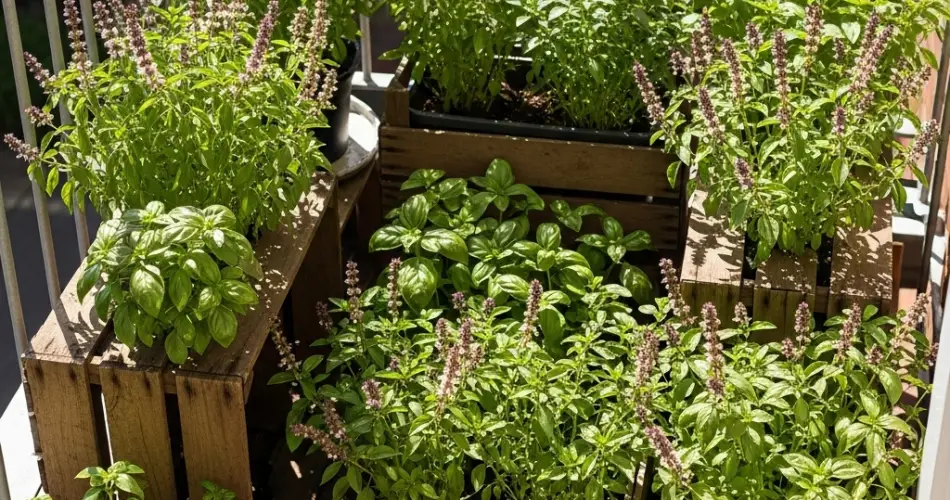Fresh basil is one of the most versatile and aromatic herbs, perfect for adding flavor to pasta, pizza, salads, and more. If you live in an apartment or have limited outdoor space, you can still grow an abundant supply of basil right on your balcony. One of the most practical and budget-friendly methods is planting basil in wooden or plastic crates. Crates provide excellent drainage, are easy to move, and allow you to grow multiple plants in one container.
With the right materials and a bit of care, your balcony can become a fragrant, green haven filled with lush basil plants.
Why Use Crates to Grow Basil?
Crates offer a number of advantages for urban gardening. They are spacious enough to grow multiple basil plants and have built-in drainage due to their open structure. You can also elevate or move them easily, making it simple to position them in the best spot for sunlight. Crates can be repurposed from old produce boxes, shipping containers, or plastic storage bins, turning everyday items into productive planters.
Basil thrives in containers as long as the roots have room to grow and the soil drains well, making crates a perfect option.
Materials You’ll Need
To grow basil in crates, gather the following items:
-
A wooden or plastic crate (around 12–18 inches deep)
-
Landscape fabric or old burlap sack (to line the crate)
-
Potting soil rich in organic matter
-
Basil seeds or seedlings
-
A small trowel or garden scoop
-
Watering can or hose with a gentle spray nozzle
-
Optional: compost or organic fertilizer
Step 1: Prepare the Crate
First, clean your crate thoroughly if it’s been previously used. If it has large slats or holes, line the inside with landscape fabric or burlap to hold in the soil while still allowing for drainage.
Place the crate in a spot on your balcony that receives at least 6 hours of sunlight per day—basil is a sun-loving plant. Make sure the crate sits on bricks, wooden slats, or another surface that allows water to drain freely from the bottom.
Step 2: Fill with Soil
Use a high-quality potting mix that’s light, fluffy, and rich in nutrients. Basil needs well-draining soil, so avoid using dense garden soil or mixes that retain too much moisture. If desired, mix in some compost to provide slow-release nutrients throughout the growing season.
Fill the crate with soil, leaving about 1–2 inches of space from the top rim to prevent overflow when watering.
Step 3: Plant Your Basil
You can start basil from seed or use transplants from a garden center.
If planting seeds:
Sprinkle the seeds evenly across the surface of the soil, then lightly cover them with a thin layer of soil (no more than ¼ inch). Water gently to moisten the soil without washing the seeds away. Seeds typically germinate in 5–10 days.
If using seedlings:
Use your trowel to dig small holes spaced 6–8 inches apart. Place the seedlings in the holes and gently pat the soil around them. Water thoroughly after planting.
Step 4: Watering and Sunlight
Basil prefers consistently moist soil but dislikes soggy conditions. Water the plants whenever the top inch of soil feels dry to the touch. In hot or windy conditions, you may need to water daily, especially in shallow containers like crates.
Make sure your basil crate gets 6–8 hours of direct sun each day. If your balcony only receives partial light, choose the sunniest spot available or consider moving the crate throughout the day if possible.
Step 5: Ongoing Care and Maintenance
To keep your basil healthy and productive:
-
Fertilize once every 2–3 weeks with a diluted organic fertilizer or compost tea.
-
Prune regularly by pinching off the top sets of leaves once the plants are about 6–8 inches tall. This encourages bushy growth and prevents early flowering.
-
Remove flowers as soon as they appear, unless you want the plant to go to seed. Flowering can cause the leaves to become bitter.
-
Check for pests like aphids or spider mites. These can usually be washed off with water or treated with a natural insecticidal soap.
Step 6: Harvesting Basil
You can start harvesting basil once the plant has at least 6 leaves. Always harvest from the top, pinching above a pair of leaves. This not only provides you with fresh basil but also encourages the plant to grow more side shoots and become fuller.
For larger harvests, cut entire stems, but leave at least half of the plant intact to allow it to continue growing. Use harvested basil immediately in recipes, store it in the fridge for a few days, or dry and freeze it for longer storage.
Final Tips
-
Rotate your crate every few days to ensure even sunlight on all sides.
-
In very hot weather, consider using mulch to retain moisture.
-
If you want continuous harvests, plant a second crate of basil 2–3 weeks after the first to create a staggered growing cycle.
-
At the end of the season, remove spent plants and refresh the soil before replanting.
Growing basil in crates is a smart, stylish, and efficient way to enjoy fresh herbs on your balcony. With just a little effort, you can transform a small outdoor space into a fragrant basil garden that provides both flavor and beauty all season long.



